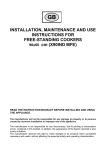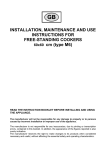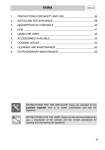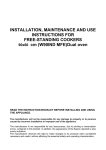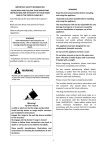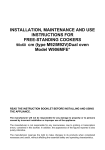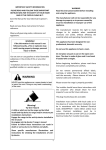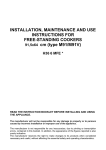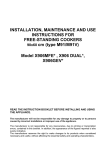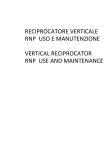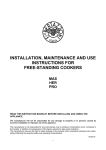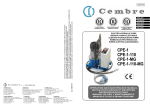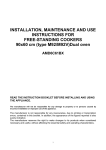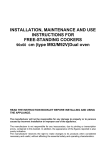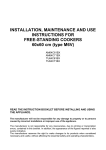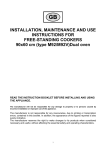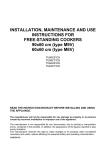Download Bertazzoni X90 IND MFE BI cooker
Transcript
INSTALLATION, MAINTENANCE AND USE INSTRUCTIONS FOR FREE-STANDING COOKERS 90x60 cm (X90IND MFE) READ THE INSTRUCTION BOOKLET BEFORE INSTALLING AND USING THE APPLIANCE. The manufacturer will not be responsible for any damage to property or to persons caused by incorrect installation or improper use of the appliance. The manufacturer is not responsible for any inaccuracies, due to printing or transcription errors, contained in this booklet. In addition, the appearance of the figures reported is also purely indicative. The manufacturer reserves the right to make changes to its products when considered necessary and useful, without affecting the essential safety and operating characteristics. CONTENTS: INSTALLER TECHNICAL MANUAL ............................................................................................................... pg. 2 Installing the cooker - Installation information ................................................................................................. pg. 2 Height adjustable legs .................................................................................................................................... pg. 3 Backguard installation instruct ........................................................................................................................ pg. 3 Electric connection .......................................................................................................................................... pg. 3 APPLIANCE MAINTENANCE - Replacing parts ............................................................................................. pg. 4 USE AND MAINTENANCE MANUAL ............................................................................................................. pg. 4 Description of control panel and control types................................................................................................. pg. 4-5 Using the induction hob ……………………………………………………………………………………………….. pg. 5 Hob control knob ………………………………………………………………………………………………………. pg. 5 Type of pan ………………………………………………………………………………………………………. pg. 6 Using the electric thermostat ........................................................................................................................... pg. 7 Using the 9+0 switch ....................................................................................................................................... pg. 7 Using the natural conventional electric oven .................................................................................................. pg. 7 Using the ventilated electric oven .................................................................................................................... pg. 8 Positioning the oven trays & shelves ............................................................................................................... pg. 9 Using the electric grill - ventilated electric grill ................................................................................................. pg. 9 Using the self cleaning oven .......................................................................................................................... pg. 10 Cleaning the appliance .................................................................................................................................... pg. 10 After-sales technical service and spare parts .................................................................................................. pg. 11 THIS APPLIANCE HAS BEEN DESIGNED FOR NON-PROFESSIONAL DOMESTIC USE. INSTALLER TECHNICAL MANUAL By ensuring this product is disposed of correctly, you will help prevent potential negative consequences for the environment and human health, which could otherwise be caused by inappropriate waste handling of this product. The symbol on the product indicates that this product may not be treated as household waste. Instead it shall be handed over to the applicable collection point for the recycling of electrical and electronic equipment. Disposal must be carried out in accordance with local environmental regulations for waste disposal. For more detailed information about treatment, recovery and recycling of this product, please contact your local city council office. INSTALLER INFORMATION The installation, all adjustments, transformations and maintenance listed in this part of the manual must be carried out only by skilled personnel. Improper installation may cause damage to persons, animals or property, for which the manufacture will not be held responsible. The appliance safety or automatic adjustment devices may be changed during the service life of the system only by the manufacturer or by the duly authorised supplier. INSTALLING THE COOKER After having removed the various loose parts from the internal and external packing, make sure that the cooker is not damaged. In case of doubt, do not use the appliance and contact skilled personnel. Keep all the dangerous packing parts (polystyrene foam, bags, cardboard, staples, etc.) away from children. The appliance can be installed as a freestanding unit, next to a wall or inserted between two walls (Fig.1). A single sidewall that exceeds the height of the work surface is possible. This must be at a minimum distance of 70 mm from the edge of the cooker (Fig. 1) Any walls of the adjacent furniture pieces and the wall behind the cooker must be made with heat-resistant material that can withstand a minimum overtemperature of 65 K. IMPORTANT INFORMATION FOR INSTALLING THE APPLIANCE The cooker can be installed separately, as a freestanding unit, on a plinth, or between kitchen units or between a kitchen unit and the wall. If installing the appliance as a freestanding cooker, screw the height adjustable telescopic legs supplied to the base of the appliance. If installing the appliance on a plinth, screw the levelling feet supplied to the base of the appliance. This appliance is not connected to devices which exhaust combustion products. Special attention must be focused on the prescriptions described below regarding room aeration and ventilation. Any hanging cabinets installed above the work surface must be located at a distance of no less than 700 mm. This appliance is not intended to be operated by means of an external timer or separate remote-control system. 2 HEIGHT ADJUSTABLE LEGS (Fig.2) Legs are packed in the top box. Legs should be installed with the appliance being near the location of final installation, they are not secure for long transport. After unpacking the range, raise it about a foot to insert the legs in their bases assembled on the lower part of the cooker and lower the range gently to keep any undue strain from legs and mounting hardware. It is recommended to use a pallet or lift jack instead of tilting the unit. BACKGUARD INSTALLATION INSTRUCTION 1) 2) 3) 4) Remove n°2 screws fixing worktop as shown in fig.3 Place front part of the backguard and attach it from bottom side with the two removed screws (point 2) as shown in fig .4 Fix the front part of the backguard with the screws supplied with the backguard kit (fig.5) Assemble back part with front part of the backguard and fix them with a screws supplied with the backguard kit (fig.6) ANTI-TILTING CHAIN The cooker is supplied with two chains which are connected to the rear left and right of the appliance. The chains should be connected to the wall directly behind the chains as low as possible to prevent the appliance from tilting forward. If the appliance is installed between two cupboards, drill a hole on each side of the cupboards, pass the chains through the holes and anchor the chains within each cupboard. Ensure the chain connections are strong enough to support the weight of the appliance and taught to prevent it from tilting forward. WARNING: In order to prevent accidental tipping of the appliance, for example a child climbing onto the open oven door, the stabilising means must be installed. Ensure the chains are correctly anchored to prevent the appliance from tilting forward and to prevent strain on the hose when the cooker is pulled forward. MAKE SURE THE ANTI-TILTING CHAINS ARE TAUGHT WHEN ANCHORED TO PREVENT THE APPLIANCE TILTING. APPLIANCE ELECTRIC CONNECTION: The electric connection must comply with the current legal standards and regulations. Before making the connection, check that: - The system electrical rating and the current outlets are adequate for the maximum power output of the appliance (see the label applied to the bottom of the casing). - The outlet or the system is equipped with an efficient ground connection in accordance with the current legal standards and regulations. The company will not be responsible for the non-compliance with these instructions. When the connection to the power supply network is made using an outlet: - If the power cord is supplied without a plug, apply a standard plug that is suitable for the load indicated on the label. Connect the wires according to the diagram shown in FIG.7 and check that: letter L (phase) = brown wire; letter N (neutral) = blue wire; = green-yellow wire; ground symbol - The power cord must be positioned so that an overtemperature of 75 K will not be reached at any point. - Do not use reductions, adapters or splitters since they might cause false contacts and lead to dangerous overheating. When the connection is made directly to the electric network: - Use a device that ensures disconnection from the mains in which the contacts are opened to a distance that permits complete disconnection according to the conditions for over-voltage category III. - Remember that the ground wire must not be interrupted by the circuit-breaker. - As an alternative, the electric connection can also be protected by a high-sensitivity residual current circuit-breaker. - It is highly recommended to attach the special green-yellow ground wire to an efficient ground system. WARNING: If the power cord is replaced, the ground wire (yellow-green) connected to the terminal, should be longer than the other wires by about 2 cm. WARNING: If the supply cord is damaged, it must be replaced by the manufacturer or its service agent or a similarly qualified person in order to avoid a hazard. For New Zealand - This cooking range must be connected to the supply by a supply cord fitted with an appropriately rated plug that is compatible with the socket-outlet fitted to the final sub-circuit in the fixed wiring that is intended to supply this cooking range. TYPES OF POWER CORDS The appliance is equipped with a terminal for the electric connection placed behind, which is accessible removing the posterior casing (Fig.8) The cable of alimentation can be : Operation at 220-240V~ : use a H05BB-F three-wire cable (cable 3x4 mm²) Operation at 380-415V2N~ : use a H05RR-F o H07RN-F four-wire cable (cable 4x4 mm²) 3 Operation at 380-415V3N~ : use a H05RR-F o H07RN-F five-wire cable (cable 5x1,5 mm²) Fig.9 The power supply cable is suitable for appliance operating on 220-240 V~ APPLIANCE MAINTENANCE ATTENTION: IMPORTANT WARNINGS For cookers resting on a base ATTENTION: If the cooker rests on a base, take the measures necessary to prevent the cooker from sliding along the support base. For cookers with glass covers ATTENTION: Before opening the appliance’s glass cover, carefully remove all liquid residues from the top of it. ATTENTION: Before closing the appliance’s glass cover, make sure that the work surface has cooled. For cookers with electric ovens During use, the appliance becomes hot. Care should be taken to avoid touching heating elements inside the oven. For cookers with electric ovens WARNING: Accessible parts may become hot during use. To avoid burns, young children should be kept away. For the food warmer compartment (or drop leaf in our case) ATTENTION: The internal parts of the food warmer can become hot during use. For glass doors Do not use harsh abrasive cleaners or sharp metal scrapers to clean the oven door glass since they can scratch the surface, which may result in shattering of the glass. Do not use steam cleaners to clean the appliance. REPLACING PARTS Before performing any maintenance operation, disconnect the appliance from the electricity network. To replace parts such as knobs, just remove them from the seats without disassembling any part of the cooker. To replace the electric thermostat, also disassemble the rear cooker guard, loosening the relative screws, to be able to pull out and reposition the thermostat bulb. To replace the oven bulb, just unscrew the protection cap that projects out inside the oven. (Fig.10) WARNING: Ensure the appliance is switched off before replacing the lamp to avoid the possibility of electric shock. WARNING: The power cord supplied with the appliance is connected to that appliance with a type Y connection (in compliance with standards EN 60335-1, EN 60335-2-6 and subsequent amendments) for which it must be replaced by the manufacturer or its service agent or a similarly qualified person in order to avoid a hazard. If the power cord becomes worn or damaged, replace it based on the information reported in table 3 . WARNING: If the power cord is replaced, the installer shall ensure that the ground cable is longer than the phase cables and also shall comply with the warnings regarding the electric connection. To replace the power cable, lift the terminal board’s cover and replace the cable. To access the terminal board in cookers with a 3x2.5mm² cable, the back panel on the rear of the appliance must be removed. USE AND MAINTENANCE MANUAL WARNING: This appliance is not intended for use by persons (including children) with reduced physical, sensory or mental capabilities, or lack of experience and knowledge, unless they have been given supervision or instruction concerning use of the appliance by a person responsible for their safety. WARNING: Children should be supervised to ensure that they do not play with the appliance. Metallic objects such as knives, forks, spoons and lids should not be placed on the hob surface since they can get hot. WARNING: SERVICING SHOULD BE CARRIED OUT ONLY BY AUTHORISED PERSONNEL. DO NOT MODIFY THIS APPLIANCE. CONTROL PANEL DESCRIPTION On the control panel, small symbols show the function of each knob or key. Here as follows are the several controls that a cooker can have: shows the disposition of induction zone on the worktop, the full dot identifies the zone in object the symbol (in this case the central zone). 4 the symbol shows the running of any left oven ( 9 positions switch) the symbol shows the electric thermostat for electric left oven USING THE INDUCTION HOB HOB CONTROL KNOB These knobs provide control of the ceramic hob's cooking zones. The zone it controls is shown above eachknob. Turn the knob to the right to set the zone's operating power; the settings range from a minimum of 1 to a maximum of 9. (fig.11) The working power is shown by a display on the hob. Heating accelerator Each cooking zone is equipped with a heating accelerator. This system allows the zone to be operated at peak power for a time proportional to the heating power selected. To start the heating accelerator, turn the knob to the left, select setting "A" and then release. The letter "A" will appear on the display on the hob. You now have 3 seconds to select the heating setting of your choice. Once a setting between 1 and 9 has been selected, "A" and the chosen setting will flash in alternation on the display. ' While the heating accelerator is in operation, the heating level can be increased at any time. The "full power" time will be modified accordingly. If the power is reduced by turning the knob anticlockwise, option "A" is automatically deactivated. Power Function The power function allows the user to operate each heating zone continuously at the maximum power for a time of no more than 10 minutes. This function can be used, for example, to bring a large amount of water to the boil in a hurry, or to turn up the heat under meat. Turn the knob clockwise and set heating level 9, then use the knob to set the "P" position and release il. "P" appears on the corresponding zone display. After 10 minutes, the power is reduced automatically, the knob returns to the 9 setting and the "P" disappears. However, the power function can be turned ott at any time by reducing the heating level. . When the power function is selected for one heating zone (e.g. the left front zone), the power absorbed by the second zone (Ieft rear zone) might be reduced to supply the maximum available energy to the first zone. Consequently, the power function takes priority over the heating accelerator. If a pan is removed from the cooking zone while the power function is on, the function is switched off. HOB ATTENTION: Metal items such as cutlery or lids must never be placed on the surface of the hob since they may become hot. Cooking zones (fig.12) The appliance is equipped with 5 cooking zones having different diameters and powers. Their positions are clearly marked by rings, while the heating power is only released in the area shown on the ceramic hob. The 5 cooking zones are of HIGH-LlGHT type and start to heat up a few seconds after they are switched on. The heat level of each zone can be regulated from the minimum to the maximum setting using the knobs on the front panel. Underneath each cooking zone there is a coil called an inductor, supplied with power by an electronic system, which generates a variable magnetic field. When a pan is placed inside this magnetic field, the highfrequency currents concentrate directly on the bottom of the pan and produce the heat needed to cook the foods. The 5 lights between the cooking zones come on when the temperature of one or more cooking zones exceeds 60° C.. The lights go out when the temperature drops to below about 60° C. Zone number: Power absorption Normal operation: With power function: 1 1100W 1400W 2 1100W 1400W 3 1400W 2000W 4 2300W 3000W 5 2300W 3000W Total power absorption 7400W 5 When the hob is used for the first time, it should be heated to its maximum temperature for long enough to bum off any oily residues left by the manufacturing process, which might contaminate foods with unpleasant smells. TYPES OF PANS This type of appliance can only operate with pans of special kinds. The bottom of the pan must be iron or steel/iron to generate the magnetic field necessary for the heating processo Vessels made from the following materials are not suitable: glass; porcelain; pottery; steel, aluminium or copper without magnetic bottom; To check that a pan is suitable, simply piace a magnet close to its bottom: if the magnet is attracted, the pan is suitable for induction cooking. If no magnet is to hand, put a little water in the pan, piace it on a cooking zone and switch it on. If the symbol appears on the display instead of the power, the pan is not suitable. The pans used for cooking must have certain minimum diameters to ensure satisfactory operation. Pans larger than the cooking zones can also be used, but it is important to ensure that the bottom of the pan does not touch other cooking zones, and that it is always centred over the perimeter of the cooking zone.(fig.13-14) Use only vessels specially designed for induction cooking, with thick, completely flat bottom; if these are not available, the pans used must not have crowned (concave or convex) bottom. (fig.15) Pan present device Each cooking zone is equipped with a "pan present" device, which ensures that cooking cannot start unless a suitable pan is present on the cooking zone and properly positioned. If the user attempts to switch on the cooking zone with the pan not positioned properly or with a pan which is not of suitable material, a few seconds after the zone is switched on the has been made. symbol will appear to warn the user that an error Residual heat Each cooking zone is equipped with a device which warns of residual heat. After any cooking zone is switched off, a flashing ‘H’ may appear on the display. This warns that the cooking zone concerned is stili very hot. Cooking can be restarted while the ‘H’ is flashing; proceed as described in point "3". Locking-out the hob When not in use, the hob can be "Iocked out" to prevent children from accidentally switching it on. With the cooking zones off, turn the knobs of zones 2 and 4 to the left simultaneously until 5 Ls appear on the power display and then release the knobs. To deactivate it, repeat the sa me procedure: the cooking zone displays will all show 0, indicating that the cooking zone lock-out function has been deactivated. Attention:Take care not to spill sugar or sweet mixtures onto the hob during cooking, or to piace materials or substances which might melt (plastic or aluminium foil) on it; if this should occur, to avoid damage to the surface, tum the heating off immediately and clean with the scraper supplied while the cooking zone is stili warm. If the ceramic hob is not cleaned immediately, residues may form which cannot be removed once the hob has cooled. Important! Keep a close eye on children because they are unlikely to see the residual heat waming lights. The cooking zones are stili very hot for some time after use, even if they are switched off. Make sure that children never touch them. WARNING: Under no circumstance use aluminium foil or plastic containers to hold the food while cooking on a glassceramic hob. WARNING: Do not touch the cooking area as long as the light indicating residual heat on the glass-ceramic hob, is “on”; this indicates that the temperature in the relative area is still high. WARNING: Never place pan with bottoms which are not perfectly flat and smooth on the hob WARNING: If you notice a crack in the ceramic hob, disconnect the appliance from the elettricity supply and contact a service centre WARNING: Your glass-ceramic hob is thermal shock resistant and resistant to both heat and cold. If you drop a heavy pot on your hob it will not break. On the contrary, if a hard object, such as the salt shaker or the spice bottle strikes the edge or the corner of the hob, the hob may break. WARNING: never use the glass-ceramic hob as support surface 6 USING THE ELECTRIC THERMOSTAT The thermostat supplied with the relative models maintains a constant temperature inside the oven at a specific temperature setting ranging from 50°C to 250°C.(fig.16) Turn the knob clockwise and align the selected temperature indicated on the ring with the index etched on the control panel. Thermostat operation is indicated by an orange light which will turn off when the temperature inside the oven is 10°C greater than the temperature setting, and will turn on when the oven is 10°C less than the temperature setting. The thermostat can control the oven elements only if the relative switch is in one of the possible oven element operating modes: if the switch is in position 0, the thermostat has not effect on the oven elements, which remain off. USING THE 9 + 0 SWITCH The 9 + 0 switch installed in the multifunction oven models is used, along with the thermostat, to control the electric fan and the oven elements since they can be turned on by turning the 9 + 0 switch knob and the thermostat knob. Turning just one of the two knobs will not have any effect on the oven except to turn on the oven light or the electric fan when inserted. The electric oven is heated by 4 elements: one on the bottom, two on the top or one circular; turning the switch knob (fig.17) turns on the element relative to the symbol indicated on the ring but to be activated the thermostat knob must be turned until the orange light turns on indicating that the element has been turned on. Placing the switch knob on any of the nine operating modes turns on the oven light, together with the relative element. Once the temperature and the elements to be used have been set, the oven elements are turned on and off by the thermostat; therefore, it is normal for the orange light to turn on and off while the oven is working. To turn off the electric oven set the switch knob to position 0 to prevent the thermostat from controlling the elements. Setting the thermostat knob to position 0 turns off the elements but it is still possible, using the switch, to turn on the electric fan and the oven light. The switch has 9 different fixed positions corresponding to 9 different types of oven operation: - the symbol indicates that only the oven light is turned on; - the symbol on; indicates that the bottom element (1800W) and the top external element (1200W) have been turned - the symbol indicates that only the top external element (1200W) has been turned on; - the symbol indicates the only the bottom element (1800W) has been turned on; - the symbol indicates that only the grill element (1800W) has been turned on; - the symbol indicates that the top external element (1200W) and the grill element (1800W) have been turned on; - the symbol been turned on; indicates that the top external element (1200W), the grill element (1800W) and the electric fan have - the symbol indicates that the circular element (3000W) and the electric fan have been turned on; - the symbol indicates that only the electric fan has been turned on. When the knob is set to one of these nine positions, the oven light is always on, thus indicating that the oven is being energised. USING THE NATURAL CONVENTIONAL ELECTRIC OVEN When using the oven for the first time it should be operated for a maximum of 30 minutes at a temperature of about 250° to eliminate any odours generated by the internal insulation. During normal oven use, select the desired cooking temperature using the thermostat knob and wait until the orange light turns off before putting in any food. The oven is equipped with 4 guides at different heights (fig.18a) which can be used to insert shelves or the tray. To keep the oven as clean as possible it is recommended to cook meat on the tray or on the shelf that has been inserted inside the tray. Table below lists the cooking times and the position of the tray for different types of foods. Personal experience will help to determine any variations in the values reported in the table. In any case, it is recommended to follow the instructions of the specific recipe being used. 7 NATURAL CONVENTIONAL ELECTRIC OVEN COOKING TABLE TEMP °C MEAT PORK ROAST 225 BEEF ROAST (YOUNG STEER) 225 BEEF ROAST 250 VEAL ROAST 225 LAMB ROAST 225 ROAST BEEF 230 ROAST HARE 250 ROAST RABBIT 250 ROAST TURKEY 250 ROAST GOOSE 225 ROAST DUCK 250 ROAST CHICKEN 250 HEIGHT MINUTES 3/4 3/4 3/4 3/4 3 3/4 3/4 3 3 3 3/4 3/4 60-80 60-80 50-60 60-80 40-50 50-60 40-50 60-80 50-60 60-70 45-60 40-45 FISH 200-225 2 15-25 PASTRY FRUIT PIE TEA CAKE BRIOCHES SPONGE CAKE RING CAKE SWEET PUFF PASTRIES RAISIN LOAF STRUDEL SAVOIA COOKIES APPLE FRITTERS SAZOIARDI SANDWICH TOAST SANDWICH BREAD PIZZA 225 175-200 175-200 220-250 180-200 200-220 250 180 180-200 200-220 200-220 250 220 220 2 2 2 2 2 2 2 2 2 2 2 3 3 2 35-40 50-55 25-30 20-30 30-40 15-20 25-35 20-30 40-50 15-20 20-30 5 30 20 USING THE VENTILATED ELECTRIC OVEN When using the oven for the first time it should be operated for a maximum of 30 minutes at a temperature of about 250° to eliminate any odours generated by the internal insulation. Before cooking, allow the oven to reach the desired temperature setting waiting for the orange light to turn off. This type of oven is equipped with a circular element around which a fan has been installed that creates forced-air circulation in the horizontal direction. Thanks to this type of operation, the ventilated oven can be used for different types of cooking at the same time, without changing the taste of each food. Only some models are equipped with a removable metallic filter applied to the rear screen which collects the fat while a roast is cooking. Therefore, it is recommended to remove this fat periodically, washing the screen with soapy water and rinsing thoroughly. To remove the metallic filter just apply slight pressure toward the top on the tab indicated by the arrow. Hot-air circulation guarantees a uniform distribution of heat. Pre-heating the oven is not necessary, but for very delicate pastries, it is recommended to heat the oven before inserting the trays. The ventilated conventional system partially changes the various notions about traditional cooking. Meat no longer needs to be turned while it is cooking and the rotisserie is no longer needed to cook a roast on the spit. Just put the meat directly on the shelf. 8 VENTILATED ELECTRIC OVEN COOKING TABLE TEMP °C HEIGHT MINUTES MEAT PORK ROAST BEEF ROAST (YOUNG STEER) BEEF ROAST VEAL ROAST LAMB ROAST ROAST BEEF ROAST HARE ROAST RABBIT ROAST TURKEY ROAST GOOSE ROAST DUCK ROAST CHICKEN 160-170 170-180 170-190 160-180 140-160 180-190 170-180 160-170 160-170 160-180 170-180 180 2 2 2 2 2 2 2 3 3 3 2 2 70-100 65-90 40-60 65-90 100-130 40-45 30-50 80-100 160-240 120-160 100-160 70-90 FISH 160-180 2-3 PASTRY FRUIT PIE TEA CAKE BRIOCHES SPONGE CAKE RING CAKE SWEET PUFF PASTRIES RAISIN LOAF STRUDEL SAVOIA COOKIES APPLE FRITTERS SAZOIARDI SANDWICH TOAST SANDWICH BREAD PIZZA 180-200 200-220 170-180 200-230 160-180 180-200 230-250 160 150-180 180-200 170-180 230-250 200-220 200-220 2 2 2 2 2 2 2 2 2 2 2 3 3 2 40-50 40-45 40-60 25-35 35-45 20-30 30-40 25-35 50-60 18-25 30-40 7 40 20 POSITIONING THE OVEN TRAYS & SHELVES The Grill Tray or Oven Shelf can be located in any of the four height positions in the oven (See Fig. 18a). Refer to the ‘Oven Cooking Tables’ for the recommended shelf position. When fitting the trays or shelves, ensure they are fitted between the two wires that are closest together (See Fig. 18b). Oven Shelves have a stop so that they are not fully withdrawn by accident. To fully remove the Oven Shelves, lift the front of the shelf slightly and withdraw fully from the oven. (See Fig. 18d) Note that the Grill Tray does not have a stop position and can be fully withdrawn without interruption, so be careful not to accidentally fully withdraw the tray. To remove the Oven Shelf Support, remove the top and bottom screws shown in Fig 18c and then pull the support from the holes in the rear oven wall. Repeat for opposite side. Replace in reverse procedure. USING THE CONVENTIONAL ELECTRIC GRILL The electric grill can also be combined with the electric oven. The grill is controlled using the oven’s temperature knob (see also, Using the electric oven). The electric grill can be used for grilling on the oven’s grill. The static electric grill must be used with the door closed. The temperature set on the thermostat (when present) must not exceed 150°C. Grilling on the shelf: In this case, the shelf supplied is placed on level 1 or 2 and the foods to be grilled are placed on top, while the tray is inserted on the lower levels to collect the cooking juices. Then turn on the grill element switching the thermostat to the relative position (electric oven version). WARNING: Accessible parts may become hot when the grill is in use. Children should be kept away. USING THE VENTILATED ELECTRIC GRILL The ventilated electric grill is a special function equipped only on the multifunction oven. Set the 9 + 0 switch to the relative position to activate the grill element and the electric fan. Generally, to ensure excellent grilling, place the oven shelf in the middle position while the oven tray should be inserted at the bottom. IMPORTANT: When using the ventilated electric grill, set the thermostat knob no higher than 175 °C, which is between the 150 °C and 200 °C setting, to avoid overheating the front of the appliance. In fact, ventilated grilling must be carried out with the door closed. 9 Note: The cooker is equipped with the cooling fan that starts operation each time the oven knob is on a position different from 0 (zero). The fan circulates the air between the control panel and the oven door and also allows the control panel and the oven door stay at a warm temperature during the appliance operation in any condition. USING THE SELF-CLEANING OVEN In the cookers where this feature is foreseen , the self-cleaning oven differs from the standard one for the fact that its internal surfaces are enamelled with a special microporous material which absorbs and eliminates the greasy particles during the cooking. In case of spillage of greasy liquids, the self-cleaning action becomes not efficient, therefore it will be necessary to clean the oven properly. Proceed in the following way: (a) wipe a humid sponge on the grease stains; (b) heat up the oven to the maximum temperature; (c) wait 5 minutes and then switch off the oven; (d) wait until the oven gets cool again; (e) wipe again the humid sponge on all the surface. Do not use detergent in any case. CLEANING THE APPLIANCE Before cleaning the appliance, it should be disconnected from the power supply. Cleaning the work surface: Periodically clean the burner heads, the enamelled steel grids, the enamelled covers and the flame caps using warm soapy water. Then those parts should be rinsed and thoroughly dried. Any liquid that overflows from pots must always be removed using a rag. If it becomes difficult to open or close a valve, do not force it, but immediately request the assistance of the technical service personnel. Cleaning the ceramic hob: Before carrying out any operations, disconnect the appliance from the electricity supply. The ceramic hob must be cleaned regularly, preferably atter each use, when the residual heat waming lights have gone out. Any marks left by the use of pans with aluminium bottoms can be wiped off with a cloth dipped in vinegar. If burnt residues are left after cooking, remove them with the scraper provided, rinse with water and dry thoroughly with a clean cloth. Regular use of the scraper considerably reduces the use of chemicals for daily cleaning of the hob. In any case, abrasive or corrosive cleaners (e.g. powder products, ovencleaner sprays, stain removers and metal scouring pads) must never be used. Cleaning the enamelled parts: To maintain the original features of the enamelled parts they should be cleaned frequently with soapy water. Never use abrasive powders. Do not leave acidic or alkaline substances on the enamelled parts (vinegar, lemon juice, salt, tomato sauce, etc.) and do not wash the enamelled parts while they are still hot. Cleaning the STAINLESS steel parts: Clean the parts with soapy water and then dry them with a soft cloth. The shine is maintained by periodically using special products that generally are found in the market. Never use abrasive powders. Cleaning the burner flame caps: Since the flame caps are resting on the burner, to clean them just remove them from their seat and wash them with soapy water. After they have been thoroughly dried and having checked that the holes are not clogged, they can be replaced in their proper position. Cleaning the inner glass door: Clean the glass with warm soapy water using a sponge. A spatula can be used to remove burner fat if used gently. ATTENTION: while cleaning the door make sure to avoid any spillage in the venting holes on the top part of the door. To clean inside the door it is necessary to disassemble the door through a service engineer. ATTENTION: for further details about cleaning of the appliance, please contact your applliance retailer. 10 AFTER-SALES TECHNICAL SERVICE AND SPARE PARTS TECHNICAL SERVICE AND SPARE PARTS Before leaving the factory, this appliance was tested and adjusted by specialist skilled staff to give the best operating results. Any subsequent necessary repairs or adjustments must be carried out with the greatest care and attention by authorised personnel. For this reason, we strongly advise you contact the Bertazzoni Service Center, specifying the nature of the problem, the model of the equipment and the serial number. This data is provided on the data label adhered to the base of the appliance and on the duplicate data label. Always use original Bertazzoni spare parts. BERTAZZONI GROUP ABN 38 069 686 326 650 Bridge Road, Richmond, Victoria 3121 Service & Spare Parts: 1300 748 308 Bertazzoni After Sales Service - P.O. Box 543 SOMERTON VIC 3061 Email: [email protected] 11 Fig. 1 Fig.2 12 Fig. 3 Fig. 4 Fig. 5 Fig. 7 Fig. 6 Fig.8 13 Fig.9 Fig.10 Fig.11 Fig.12 Fig.13 Fig.14 14 Fig.15 Fig.16 Fig.17 Fig.18a Fig.18b Fig.18d Fig.18c 15 OVERALL DIMENSIONS Cod. 310988 16
















